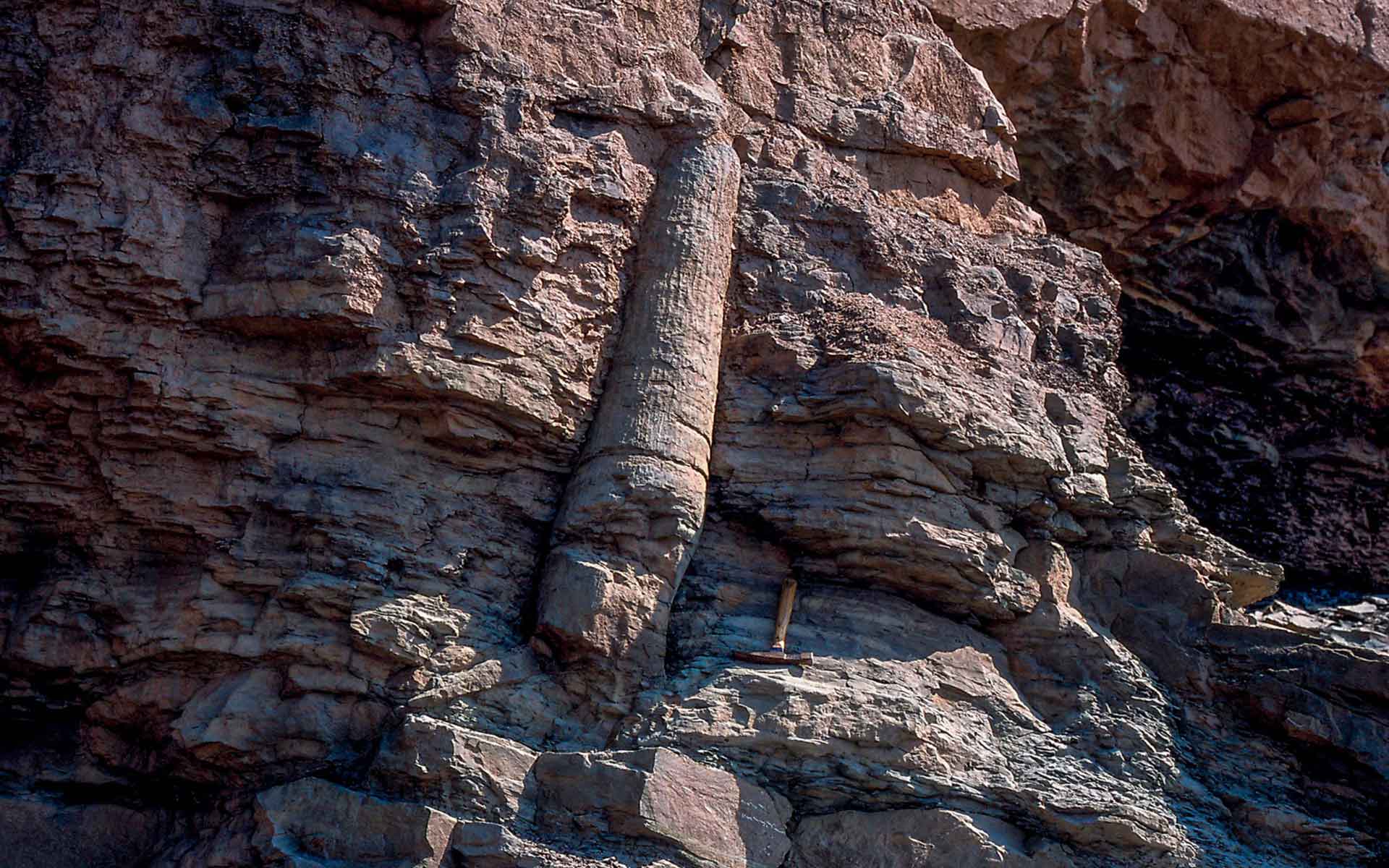
One of the standing fossil trees for which Joggins is famous, in which are found fossils of the world’s earliest reptiles. (Photo: Andrew MacRae).
Geological Period
Carboniferous
Main geological interest
Paleontology
History of geoscience
Location
Nova Scotia, Canada.
45°23’15.0″N, 64°02’54.0″W
One of the standing fossil trees for which Joggins is famous, in which are found fossils of the world’s earliest reptiles. (Photo: Andrew MacRae).
The world’s best example of "Coal Age" tropical forests and site of oldest known reptiles.
This IUGS Geological Heritage site was inscribed on the UNESCO list of the World Heritage as the most outstanding example in the world of terrestrial life in the Pennsylvanian “Coal Age”. It includes the iconic elements of this period of Earth history – the Coal Age forest ecosystem that gave rise to the coal deposits of Europe and North America and in which evolved the earliest reptiles and first amniotes in the history of Life. From the ‘Origin of Species’ to current research, Joggins has played a seminal role in the development of geology and evolutionary science.
- Geological description
The coastal cliffs of Joggins, hewn by the highest tides in the world, expose anew fossil trees of the great tropical forest swamps that gave rise to the coal deposits of Europe and North America (Calder et al., 2006). Visited and studied by Sir Charles Lyell and Sir William Dawson in the Nineteenth Century (Lyell and Dawson, 1853), the cliffs were cited as the best possible exposure of the fossil record by Charles Darwin in his seminal work ‘On the Origin of Species’ (Darwin, 1859).
The standing trees have captured the imagination of scientists and citizen scientists alike because of the fossils contained in their once hollow trunks. These fossils include the earliest reptile and amniote in the fossil record, Hylonomus lyelli (Carroll, 1964). Over 100 individual tetrapods (amphibians and reptiles) have been discovered within the trees of Joggins, historically ascribed to having fallen victim to open pitfalls. More recent analysis suggests that these tetrapods, along with millipedes and the earliest land snails, denned inside the tree hollows (Calder, 2017).
Examples of life in these tropical swamp forests include trackways of one of the largest terrestrial myriapods Arthropleura, scorpions, whip spiders, footprints of tetrapods, aquatic fauna in beds that derive from basinwide flood events, and foliage and stems of the tropical forests themselves.
- Scientific research and tradition
Scientists have been drawn to the Joggins cliffs for more than two centuries to ponder the record of standing fossil forests and life here, and even earlier to mine coal formed from the primeval peatlands (Calder, 2017). The importance of Joggins in unravelling the evolution of reptiles continues today, with continuing discoveries (Mann et al., 2020).
- Reference
Calder, J. (2017) The Joggins Fossil Cliffs: Coal Age Galapagos. Second Edition. Halifax: Formac Publishing Company.
Calder, J.H. et al. (2006) ‘A fossil lycopsid forest succession in the classic Joggins section of Nova Scotia: Paleoecology of a disturbance-prone Pennsylvanian wetland’, in Wetlands Through Time. S.F. Greb and W.A. DiMichele (editors). (Geological Society of America Special Paper, 399), pp. 169–195. Available at: https://pubs.geoscienceworld.org/gsa/books/book/557/chapter/3802480/A-fossil
lycopsid-forest-succession-in-the-classic.
Carroll, R.L. (1964) ‘The earliest reptiles’, Journal of the Linnean Society of London, Zoology, 45(304), pp. 61–83. Available at: https://doi.org/10.1111/j.1096-3642.1964.tb00488.x.
Darwin, C. (1859) On the origin of species by means of natural selection, or the preservation of favoured races in the struggle for life. First edition. London: John Murray. Available at: http://archive.org/details/darwin-online_1859_Origin_F373.
Lyell, C. and Dawson, J.W. (1853) ‘On the Remains of a Reptile (Dendrerpeton Acadianum, Wyman and Owen) and of a Land Shell discovered in the Interior of an Erect Fossil Tree in the Coal Measures of Nova Scotia’, Quarterly Journal of the Geological Society, 9(1–2), pp. 58–67. Available at: https://doi.org/10.1144/GSL.JGS.1853.009.01-02.20.
Mann, A. et al. (2020) ‘Reassessment of historic “microsaurs” from Joggins, Nova Scotia, reveals hidden diversity in the earliest amniote ecosystem’, Papers in Palaeontology, 6(4), pp. 605–625. Available at: https://doi.org/10.1002/spp2.1316.
- Author(s)
Cliffs of Fundy UGGp, Canadian Geoparks Network and Saint Mary’s University, NS, Canada


